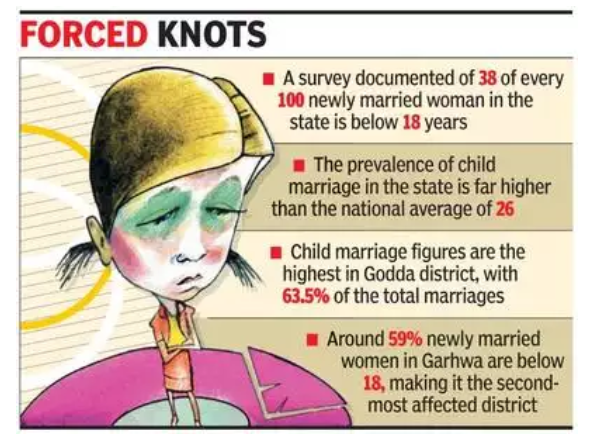Monday, 1st January 2024
Shahi Idgah and Krishna Janmabhoomi Temple Dispute
In News: The Allahabad High Court has recently mandated a survey to be carried out for the Shahi Idgah, a mosque with three domes located in Mathura.
History of the Disputed Land
- Raja Veer Singh Bundela of Orchha erected a temple on the same premises in 1618, while the mosque was constructed by Aurangzeb in 1670, replacing an earlier temple.
- The Krishna Janmasthan temple in Mathura is believed to have originated around 2,000 years ago in the 1st century CE.
- A survey has been ordered in response to Hindu representatives' demands for full ownership of the premises, where the Keshava Deva temple was demolished on the orders of Mughal emperor Aurangzeb in 1670.
- The area was initially considered nazul land, owned by the Marathas and later the British.
- The temple, first built in 1618 during Jahangir's reign, was supported by Aurangzeb's brother and rival, Dara Shukoh. In 1815, the Raja of Benaras acquired the 13.77-acre land from the East India Company.
- Subsequently, the Shri Krishna Janmabhoomi Trust was established, gaining ownership rights over the temple.
- In 1951, the land was placed under the trust with a stipulation against selling or pledging.
- The Shri Krishna Janmasthan Sewa Sangh was established in 1956 to manage the temple affairs.
- In 1968, an agreement between the Sri Krishna Janmasthan Seva Sangh and the Shahi Idgah Masjid Trust saw the temple authority conceding a portion of the land to the Idgah.
- The current dispute involves temple petitioners seeking possession of the entire parcel of land.
Present Status of the Issue
- A plea for a survey was filed on behalf of the Hindu deity Shri Krishna and seven others, who claim that the mosque was built over the birthplace of Shri Krishna on Aurangzeb's orders in 1670.
- Since the 2019 Babri Masjid judgment, nine cases related to the Shri Krishna Janmabhoomi and Shahi Idgah Masjid have been filed in the Mathura court.
- The Allahabad High Court consolidated all suits pertaining to the Sri Krishna Janmabhoomi-Shahi Idgah Mosque dispute.
- In the High Court, the U.P. Sunni Central Waqf Board and the Shahi Idgah Masjid Committee argued against the plaintiffs' claim, asserting a lack of evidence and reliance on speculation.
- When the Committee of Management Trust sought a stay on the survey from the Supreme Court, no relief was granted.
Places of Worship Act, 1991
- About
- Enacted to preserve the status of religious places of worship as of August 15, 1947, the act prohibits conversion of any place of worship and ensures the maintenance of their religious character.
- Major Provisions of the Act
- Prohibition of Conversion (Section 3)
- Prevents the conversion of a place of worship, whether in full or part, from one religious denomination to another or within the same denomination.
- Prohibition of Conversion (Section 3)
- Maintenance of Religious Character (Section 4(1))
- Ensures that the religious identity of a place of worship remains the same as of August 15, 1947.
- The Allahabad High Court's recent stance in the Gyanvapi case indicates that the Places of Worship Act, 1991, does not clearly define the "religious character of any place of worship" and can only be determined in a trial based on documentary and oral evidence on a case-by-case basis.
- Abatement of Pending Cases (Section 4(2))
- Declares termination of ongoing legal proceedings concerning the conversion of a place of worship's religious character before August 15, 1947, and bars initiation of new cases.
- Exceptions to the Act (Section 5)
- Excludes ancient and historical monuments, archaeological sites, and remains covered by the Ancient Monuments and Archaeological Sites and Remains Act, 1958.
- It also does not apply to cases already settled, resolved disputes, or conversions before the Act's enactment.
- The Act doesn't extend to the specific place of worship known as Ram Janmabhoomi-Babri Masjid in Ayodhya, including associated legal proceedings.
- Penalties (Section 6)
- Specifies penalties, including a maximum imprisonment term of three years and fines, for violating the Act.
Source: TH
Kerala Leads Nation in NH Land Acquisition Contributions
In News: The Ministry for Road Transport and Highways (MoRT&H) recently submitted a document to Parliament, revealing that Kerala bears the highest financial burden, followed by Haryana and Uttar Pradesh.
Key Highlights of the Document
- Expenditure on Land Acquisition
- Over the past five years, the National Highways Authority of India (NHAI) has allocated the highest funds for land acquisition and related activities in Maharashtra, with Uttar Pradesh and Kerala following suit.
- Kerala's Proposal for Waiver
- Kerala has presented a proposal seeking a waiver of the 25% share for land acquisition in two NHAI projects - the Ernakulam bypass and Kollam-Shenkottai stretch.
- Additionally, Kerala aims for an exemption from sharing the land acquisition costs for the Outer Ring Road project by including it under the Bharatmala Pariyojana.
- **Financial Obligations of Haryana and Uttar Pradesh:**
- As per the documents, Haryana and Uttar Pradesh are obligated to pay Rs. 3,114 crore and Rs. 2,301 crore, respectively.
Challenges Related to Land Acquisition in India
- High Financial Cost
- The amended Land Acquisition Act of 2013 has significantly increased the financial burden of land acquisition in India, emphasizing higher compensation and consent requirements for landowners.
- Environmental Clearance Delays
- Project timelines and costs are impacted by delays and uncertainties in obtaining environmental clearance and land acquisition notifications.
- Conflicts and Protests
- Communities affected by projects often resist based on environmental, social, or cultural concerns.
- Transparency and Accountability Issues
- Lack of awareness among landowners regarding their rights and entitlements often leads to coerced land sales at lower prices.
- Government agencies involved in land acquisition may deviate from principles of natural justice and fair compensation.
- Legal Framework Challenges
- Outdated and complex laws governing land acquisition create confusion and uncertainty, lacking clarity on financial cost, environmental clearance, dispute resolution mechanisms, etc.
Government Initiatives to Reform Land Acquisition
- LARR Act of 2013
- Replaced the Land Acquisition Act of 1894, introducing provisions for compensation, consent, social impact assessment, and rehabilitation.
- SVAMITVA Scheme
- Launched in 2020, providing property cards to rural landowners to use their land as a financial asset.
- SEZs Act, 2005
- Enacted to facilitate SEZs in India, providing incentives and exemptions for export-oriented industries.
- Bhoomi Rashi Portal
- An e-Governance initiative of the Ministry of Road Transport & Highways, digitizing and automating the land acquisition process for National Highways.
- PM Gati Shakti and Bharatmala Schemes
- Government schemes aimed at infrastructure development and streamlining land acquisition processes.
Way Forward
- Enhancing Transparency and Accountability
- Adopting best practices like online mapping systems, public hearings, social impact assessments, and grievance redressal mechanisms.
- Fair Compensation and Rehabilitation
- Ensuring fair compensation and rehabilitation by considering market value, alternative sites, livelihood support, and social security.
- Minimizing Environmental Impacts
- Adopting measures such as environmental clearance, impact assessments, mitigation, and monitoring mechanisms.
- Reforming Legal Framework
- Simplifying, updating, and harmonizing laws, while strengthening enforcement mechanisms for land acquisition.
|
UPSC Previous Year Questions Prelims (2017) Q. With reference to ‘National Investment and Infrastructure Fund’, which of the following statements is/are correct?
Select the correct answer using the code given below: (a) 1 only Ans: (d)
Mains (2021) Q. “Investment in infrastructure is essential for more rapid and inclusive economic growth.” Discuss in the light of India’s experience. |
Source: TH
Electronic Soil - Edukemy Current Affairs
In News: Researchers at Linköping University in Sweden have recently created an 'Electronic Soil' capable of accelerating plant growth in hydroponic environments.
Electronic Soil (eSoil)
- Overview
- The developed electronic soil (eSoil) is an innovative conductive growth medium designed specifically for hydroponic systems.
- In contrast to conventional substrates like mineral wool, known for their non-biodegradability and energy-intensive manufacturing processes, eSoil consists of cellulose, a biopolymer, combined with a conductive polymer called PEDOT (Poly(3,4-ethylenedioxythiophene)).
- This unique material blend enables the stimulation of plant root systems through the application of low-power electrical currents.
- Significance
- eSoil presents a breakthrough in reduced energy consumption and mitigates the risks associated with high-voltage systems.
- Its significance lies in its ability to promote plant growth, demonstrated by a study revealing a 50% increase in the growth rate of barley seedlings cultivated in hydroponic systems using this technology.
- The synergy of hydroponics with eSoil holds promise for addressing global food demands, particularly in urban environments where arable land is scarce.
Hydroponics
- Definition
- Hydroponics is a cultivation method where plants grow in a nutrient-rich, water-based solution without the use of soil.
- Instead, the root system is supported by inert media like perlite, rockwool, clay pellets, peat moss, or vermiculite.
- The core principle involves allowing plant roots to directly contact the nutrient solution while ensuring access to essential oxygen for proper growth.
- Advantages
- Land and Water Efficiency
- Hydroponic farming, especially with closed water loop systems, proves advantageous for farmers facing limitations in both land and water resources.
- Suitability for Urban Areas
- Soilless systems gain significance in urban and peri-urban areas, where arable land is often contaminated.
- Lower Resource Consumption
- Efficient resource utilization makes hydroponic farming an attractive option for various stakeholders.
- Higher Yield
- According to the Food and Agricultural Organization (FAO), soilless systems yield 20-25% more vegetables than traditional systems due to a higher number of plants per square meter.
- Land and Water Efficiency
- Drawbacks
- Maintenance Intensive
- Regular water replacement is essential to prevent the spread of plant diseases in standing or recirculating water.
- Water and Electricity Dependency
- Hydroponic farming relies significantly on water and electricity. In the absence of a stable water supply or electricity, the system may not thrive optimally.
- Maintenance Intensive
|
UPSC Previous Year Questions Prelims (2020) Q. What is the use of biochar in farming?
Which of the statements given above is/are correct? (a) 1 and 2 only Ans: (d)
|
Source: IE
Internationalisation of Indian Currency
In News: India recently made its first-ever payment in rupees for crude oil from the UAE, signaling a crucial advancement in the internationalization of the Indian currency.
Internationalisation of Rupee
Overview
- The internationalisation of the rupee is a progressive process aimed at increasing the usage of the local currency in cross-border transactions.
- It encompasses the promotion of the rupee in import/export trade, current account transactions, and eventually, its integration into capital account transactions.
Historical Context
- In the 1950s, the Indian rupee served as legal tender in the United Arab Emirates, Kuwait, Bahrain, Oman, and Qatar.
- However, the devaluation of the rupee in 1966 prompted these countries to introduce sovereign currencies, reducing reliance on the Indian rupee.
Benefits of Internationalisation of Rupee
- Appreciate Currency Value
- Enhancing demand for the rupee in international trade can lead to increased convenience and reduced transaction costs for businesses and individuals engaged with India.
- Reduced Exchange Rate Volatility
- Internationalisation tends to stabilize the exchange rate of the currency, reducing volatility.
- This makes it more predictable and reliable for global transactions.
- Geopolitical Advantages
- Internationalising the rupee can bolster India's geopolitical influence, fostering economic ties, bilateral trade agreements, and diplomatic relations.
- Fortify Indian Economy
- Diversifying settlement currencies can strengthen India's economy against global currency shocks by reducing dependency on the dollar.
Challenges
- Triffin Dilemma
- Balancing domestic economic stability and meeting global demand for the rupee poses a challenge, known as the Triffin dilemma.
- It involves conflicting demands as a reserve currency issuer.
- Exchange Rate Volatility
- Opening the currency to international markets may initially increase exchange rate volatility, impacting trade and investments.
- Impact on Import Costs
- A stronger rupee due to internationalisation may impact the cost of imports, potentially affecting trade balances.
- Limited International Demand
- The rupee's daily average share in the global forex market is modest, posing challenges for broader international use.
- Convertibility Concerns
- Limited convertibility of the INR restricts its widespread use in international trade and finance.
- Demonetization Impact
- Demonetization exercises in 2016 and recent currency withdrawals have impacted confidence in the rupee, particularly in neighboring countries.
- Challenges in Trade Settlement
- Efforts to settle trade in rupees with various countries have faced limitations, and negotiations with Russia have been slow.
Steps Towards Internationalisation
- Developments in the GIFT City
- Advancements in the Gujarat International Finance Tec-City contribute to the internationalisation process.
- Asian Clearing Union (ACU)
- The ACU facilitates trade settlement among member countries, and in 2023, the RBI implemented rupee trade settlement with 18 countries.
Reforms that India Can Pursue
- Make the Rupee More Freely Convertible
- A gradual move towards full convertibility by 2060 would enhance liquidity and attractiveness for foreign investors.
- Reforms Suggested by Tarapore Committee
- Implementing strong fiscal management, liberalised schemes for personal remittance, removal of restrictive clauses for stock options, and reorienting relevant departments are recommended.
- Pursue a Deeper Bond Market
- Encouraging a deeper bond market would provide more investment options in rupees for foreign investors and trade partners.
- Encourage Transactions in Rupee
- Optimising trade settlement formalities for rupee import/export transactions can promote its usage.
- Sign Additional Currency Swap Agreements
- Agreeing on currency swap arrangements with more countries, as seen with Sri Lanka and Japan, supports trade settlement in rupees.
- Ensure Currency Management Stability
- Avoiding sudden or drastic changes in currency management nsures confidence and stability.
Conclusion
The recommendations of the Tarapore Committee from 1997 and 2006, combined with proactive steps such as advocating for the rupee's recognition in international organizations, can pave the way for a successful internationalisation process.
|
UPSC Previous Year Questions Prelims (2015) Q1. Convertibility of rupee implies (a) being able to convert rupee notes into gold Ans: (c) Prelims (2014) Q2. With reference to Balance of Payments, which of the following constitutes/ constitute the Current Account?
Select the correct answer using the code given below: a. 1 only Ans: (c) |
Source: TH
Tree Ambulance - Edukemy Current Affairs
In News: The Horticulture Department of the Municipal Corporation of Delhi (MCD) intends to increase its tree ambulance fleet in Delhi, with the goal of expanding the current number to 12 by 2024.
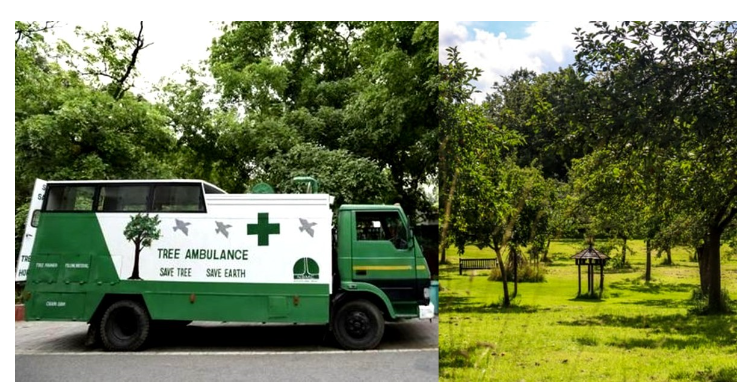
Tree Ambulance
- Overview
- The Tree Ambulance initiative was launched to champion the cause of "save trees" with a broader vision to protect the Earth.
- The inaugural phase of the Tree Ambulance took place in Chennai on the International Day for Biological Diversity in 2019 (celebrated on May 22nd), inaugurated by the Vice President of India.
- Operations
- Tree Ambulances are operated by a team comprising botanists, forestry experts, gardeners, volunteers, and tree surgeons.
- They offer complimentary services to individuals who contact the helpline seeking assistance in rescuing ailing trees and plants.
- Objective
- Proposed by the renowned environmentalist K Abdul Ghani, also known as the "Green Man of India," the initiative aims to combat climate change by replanting trees uprooted during events like Cyclone Vardah and Cyclone Gaja.
- The Tree Ambulance provides diverse services, including first aid treatment, seed banking, seed ball distribution, uprooted tree planting, plant distribution, assistance in tree plantation, tree shifting, tree surveying, and removal of dead trees.
- Significance
- The Tree Ambulance initiative is gaining momentum across India, reviving ailing plants and contributing to the mitigation of "urban heat islands," thus aiding in cooling down cities.
- Furthermore, these tree ambulances play a crucial role in preserving biodiversity.
Source: HT
Litchi Cultivation - Edukemy Current Affairs
In News: An official from the National Research Centre on Litchi (NRCL) has recently stated that the cultivation of litchi is now widespread, encompassing 19 states across India.
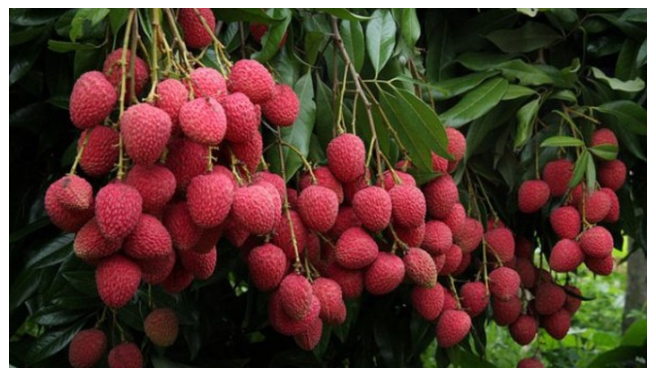
Litchi Cultivation Overview
- Introduction
- Litchi, a delectably juicy fruit known for its excellent quality, belongs botanically to the Sapindaceae family.
- In India, the translucent and flavorful aril or edible flesh of the litchi is widely enjoyed as a table fruit.
- Agro-climatic Requirements
- Litchi is a sub-tropical fruit that thrives best in a moist sub-tropical climate.
- Ideally suited for low elevations, it can be cultivated up to an altitude of 800 m.
- The crop flourishes in deep, well-drained loamy soil rich in organic matter, with an ideal pH range of 5.0 to 7.0.
- Temperature
- Maintaining an optimum temperature is crucial, with a maximum of 40.5°C in summer and avoiding freezing points in winter.
- The young trees require protection against frost and hot winds until firmly established, as some temperature variation is necessary for proper fruiting.
- Rainfall
- While litchi appreciates moisture, prolonged rain, particularly during flowering, can be detrimental as it interferes with pollination.
- Cultivation Spread in India
- Traditionally, commercial litchi cultivation in India was concentrated in the north, in the foothills of the Himalayas from Tripura to Jammu & Kashmir, and the plains of Uttar Pradesh and Madhya Pradesh.
- However, driven by increasing demand and the crop's viability, commercial cultivation has expanded to states like Bihar, Jharkhand, Madhya Pradesh, Chhattisgarh, among others.
- Global Scenario
- India holds the position of the second-largest producer of litchi globally, following China.
- Other major litchi-producing countries include Thailand, Australia, South Africa, Madagascar, and Florida in the United States.
Source: DTE
Neora Valley National Park - Edukemy Current Affairs
In News: A recent image captured by trap cameras at West Bengal's Neora Valley National Park has officially confirmed the presence of Royal Bengal Tigers at an elevation of 10,509 feet above sea level.
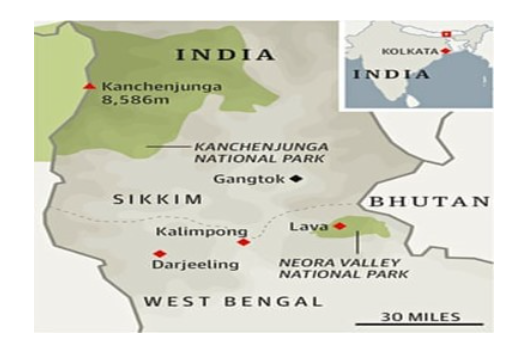
Neora Valley National Park Overview
- Location
- Situated in the Kalimpong district of West Bengal, Neora Valley National Park stands as one of the most biodiverse zones in the entire Northeast region of India.
- Boundaries
- The park shares contiguous boundaries with Sikkim and Bhutan to the north and northeast, connecting to the Pangolakha Wildlife Sanctuary in Sikkim and the Toorsa Strict Reserve in Bhutan.
- To the south, it adjoins the forests of Jalpaiguri district, linking with the Chapramari Wildlife Sanctuary and the Gorumara National Park.
- The highest point within the park is Rachela Pass.
- Ecosystem Characteristics
- Encompassing the features of the Himalayan Montane System, Indian Peninsular Sub-region, and the Malayan sub-region, Neora Valley National Park showcases a rich diversity of habitat types.
- These include Subtropical Mixed Broadleaf Forest, Lower Temperate Evergreen Forest, Upper Temperate Mixed Broadleaf Forest, and Rhododendron Forest.
- Vegetation
- The park boasts a variety of vegetation types, including Dry Mixed Forest, Wet Mixed Forest, Lauraceous Forest, Bak-Oak Forest, High-level Oak Forest, Coniferous Forest, and Himalayan Moist Temperate Forest.
- Flora
- Diverse forests within the park feature a mix of species such as rhododendron, bamboo, oak, ferns, and sal.
- Fauna
- Neora Valley National Park is home to a rich array of wildlife, including Red Panda, Himalayan Tahr, Himalayan Black Bear, Sambar, Barking Deer, Serow, Goral, Dhole, and Gaur.
Source: TI
Parkinson’s Disease- Edukemy Current Affairs
In News: Brain researchers in India have recently unraveled the intricate dynamics between two essential brain chemicals, shedding light on how their complex interplay contributes to the onset of Parkinson's Disease.

Parkinson’s Disease Overview
- Definition
- Parkinson’s Disease is a progressive neurological disorder impacting the nervous system and areas of the body governed by nerves.
- It manifests as a condition where individuals experience limited or no control over their movements and body balance.
- Prevalence
- The risk of developing Parkinson’s disease rises naturally with age, typically initiating around 60 years old.
- Studies have indicated a higher likelihood of men being affected by Parkinson’s compared to women.
- Cause
- The root cause lies in the degeneration of nerve cells in the substantia nigra, a region of the brain controlling movement.
- The impaired or dying nerve cells result in a deficiency of dopamine, a vital chemical for coordinating the movement of millions of nerve and muscle cells.
- This deficiency leads to the characteristic symptoms of slowed movements and tremors in Parkinson's disease.
- Symptoms
- Symptoms vary among individuals, with early manifestations often mild and easily overlooked.
- They typically commence on one side of the body and tend to remain more pronounced on that side.
- Parkinson's symptoms encompass tremors, rigidity, slowness of movement, impaired balance, and coordination.
- Additional symptoms may include difficulty in swallowing, chewing, and speaking, along with urinary problems, constipation, skin issues, depression, emotional changes, and disruptions in sleep.
- Diagnosis
- At present, no blood, laboratory, or radiological tests are available for diagnosing Parkinson’s disease.
- Treatment
- While there is no cure for Parkinson’s Disease, available treatments can significantly alleviate symptoms.
Source: DH
Indian Olympic Association (IOA)
In News: Recently, the Indian Olympic Association (IOA) established a three-member ad hoc committee to oversee the day-to-day operations of the Wrestling Federation of India (WFI).
Indian Olympic Association (IOA) Overview
- Role
- The IOA serves as the apex body governing the Olympic Movement and the Commonwealth Games in India.
- Holding affiliation with key international bodies like the International Olympic Committee (IOC), Commonwealth Games Federation (CGF), Olympic Council of Asia (OCA), and Association of National Olympic Committees (ANOC), the IOA takes charge of sports governance and athletes’ welfare within the country.
- Responsibilities
- As an affiliated member, the IOA manages the representation of Indian athletes or teams participating in various international events, including the Olympic Games, Commonwealth Games, Asian Games, and other multi-sport competitions organized by the IOC, CGF, OCA, and ANOC.
- Initiatives
- Beyond event participation, the IOA has initiated various programs in collaboration with different stakeholders to foster sports education and Olympic studies.
- Recognition
- The IOA holds recognition from the Ministry of Youth Affairs and Sports in India.
- Foundation
- Established in 1927 with Sir Dorabji Tata as the Founding President and Dr. A.G. Noehren as the Secretary General, the IOA operates as a Non-Profit Organization under the Societies Registration Act of 1860.
- Membership
- Comprising National Sports Federations (NSFs), State Olympic Associations, IOC Members, and select multi-sport organizations, IOA's membership aligns with the Olympic Charter.
- NSFs governing sports featured in the programs of the Summer Olympic Games, Winter Olympic Games, Asian Games, and Commonwealth Games are prominently represented.
- Governance
- Currently governed by a 32-member Executive Council with a President at the helm, the IOA conducts elections for the Executive Council every four years.
- The Executive Council's functioning is further facilitated by various Standing Committees consisting of subject experts to contribute to different aspects of governance.
Source: TOI
Warli painting - Edukemy Current Affairs
In News: Recently, an exhibition organized by the Inherited Arts Forum highlights the artistic journey of the renowned Mashe family and their contributions to the revival of Warli painting.
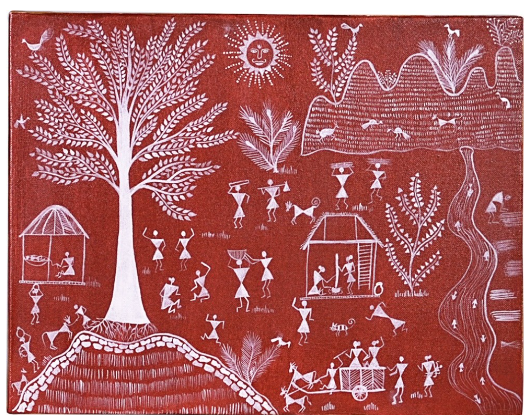
Warli Paintings Overview
- Origin
- Warli Paintings are a distinctive tribal art form originating from the tribal communities residing in the North Sahyadri Range in Maharashtra.
- Though its roots can be traced back to the 10th century AD, the art gained recognition for its unique style only in the early 1970s.
- Traditional Practitioners
- Traditionally, Warli Paintings were crafted by the women of the Warli tribe known as Suvasinis.
- These artisans adorned the Lagn Chowk, or wedding square, with their creations.
- Theme
- Warli art captures the essence of rural life, portraying the daily routines of tribal communities, their deep connection with nature, gods, myths, traditions, customs, and festive celebrations.
- The paintings employ fundamental geometric shapes, predominantly featuring a circle, a triangle, and a square.
- The central motif is the square, referred to as "chauk" or "chaukat," with two main types known as Devchauk and Lagnachauk.
- Cultural Depictions
- Many Warli paintings depict the tarpa dance, a significant cultural aspect.
- The tarpa, resembling a trumpet, is played by different village men in turns, while men and women join hands and form a circle around the tarpa player.
- Painting Technique
- The creation process involves selecting a design, which is then directly drawn on paper or cloth without tracing.
- Cleverly modified bamboo sticks serve as paintbrushes to bring the paintings to life.
- Materials
- Colors used in Warli Paintings are derived from natural sources, with brown and orange from henna, indigo from dye, red from bricks, and white from thick rice paste.
Source: TH
India-Russia Diplomatic Artistry
In News: A recent article explores the visit of India's Foreign Minister, Jaishankar, to Moscow, underscoring its crucial role in enhancing the ties between India and Russia.
Why the Strategic Significance of India-Russia Relationship?
Time-Tested Partners
- Collaboration since Cold War
- During the Cold War, the Soviet Union held a key position in the partnership, with India collaborating closely as part of the Non-Aligned Movement.
- Indo-Soviet Friendship Treaty of 1971
- Russia supported India during the Indo-Pak war, solidifying their alliance.
- Strategic Partnership Declaration (2000)
- India-Russia ties entered a new phase with increased cooperation in various areas.
Energy Security
- Rich Natural Gas Reserves
- Russia possesses vast natural gas reserves, aligning with India's transition towards increased reliance on natural gas.
- Joint Initiatives
- India actively imports hydrocarbons from the Russian Far East, emphasizing energy security.
- Nuclear Energy Cooperation
- The Kudankulam Nuclear Power Plant in Tamil Nadu showcases collaboration in the peaceful use of nuclear energy.
Economic Convergence
- Bilateral Trade Growth
- Russia is India’s seventh-largest trading partner, with bilateral trade surpassing USD 45 billion.
- Bilateral Investment Goals
- Both countries aim to increase bilateral investment to USD 50 billion by 2025.
Balancing Geopolitics
- Countering Chinese Aggression
- Russia can contribute to defusing tensions with China, showcasing the strategic partnership's balancing role.
- Champions of Multipolarism
- Both nations support a multi-polar world, advocating for expanded Security Council membership.
Enduring Defence Ties
- Military Technical Cooperation Agreement
- Guided by this agreement, Russia commands around 47% of India's total arms imports.
- Historical Collaboration
- Russian technology dominates India's armored force and ground-attack aircraft, emphasizing the enduring nature of defence ties.
- S-400 Triumf Missile Deal (2018)
- India's significant defence purchases from Russia, like the S-400 deal, showcase continued collaboration.
Key Issues in India-Russia Relationship
- Russia's Closer Ties with China
- Russia's deepening relations with China introduce a geopolitical dynamic that may impact India's traditional strategic considerations.
- Increasing Proximity with Pakistan
- Russia's efforts to improve relations with Pakistan pose challenges for India's diplomatic stance.
- Diplomatic Dilemma for India
- Balancing its "comprehensive global strategic partnership" with the US against its "special and privileged partnership" with Russia presents challenges.
- Ukraine Crisis
- India's cautious response to the Ukraine crisis drew criticism from the West, impacting its global image.
- Declining Economic Engagement
- India's desire to diversify defence imports and dissatisfaction with post-sales services have led to a gradual decline in orders from Russia.
Way Forward for India-Russia Relationship
Balancing the Defence Dynamics
- Enhanced Defence Collaboration
- Focus on modernizing and diversifying defence collaboration.
- Joint Military Production
- Explore opportunities for joint production and export of Russian-origin equipment.
Facilitating Economic Engagement
- Diversification of Economic Ties
- Focus on expanding economic relations, exploring new sectors, and encouraging investments.
- Rupee-Ruble Mechanism
- Adopt the Rupee-Ruble mechanism to safeguard bilateral trade from Western sanctions.
Balancing the Global Dynamics
- Multilateral Engagement
- Coordinate in multilateral forums, advocate shared values, and address common challenges globally.
- Institutional Mechanisms
- Strengthen institutional mechanisms for regular dialogue and collaboration.
Forging Technological Cooperation
- Innovation and Technology Cooperation
- Collaborate in emerging technologies like AI, space exploration, and cybersecurity.
- Energy Security
- Explore cooperation in oil and gas exploration, renewable energy, and energy infrastructure development.
Promoting Cultural Connectivity
- Yoga and Cultural Diplomacy
- Leverage Yoga's popularity in Russia for cultural diplomacy.
- Public Diplomacy
- Engage in public diplomacy efforts through media and cultural events to promote positive narratives.
Conclusion
India-Russia relations, grounded in trust and common interests, remain resilient. Open communication, shared commitment to global peace, and adaptation to global shifts will determine the success of this enduring partnership. As the Indian Foreign Minister emphasized, "Geopolitics and strategic convergence will always keep India-Russia ties on a positive trajectory."
|
UPSC Previous Year Questions Prelims (2019) Q., Recently, India signed a deal known as ‘Action Plan for Prioritization and Implementation of Cooperation Areas in the Nuclear Field’ with which of the following countries? (a) Japan Ans: B Mains (2020) Q. What is the significance of Indo-US defence deals over Indo-Russian defence deals? Discuss with reference to stability in the Indo-Pacific region. |
Source: IE
Share the article
Edukemy’s Current Affairs Quiz is published with multiple choice questions for UPSC exams
MCQ
Get Latest Updates on Offers, Event dates, and free Mentorship sessions.

Get in touch with our Expert Academic Counsellors 👋
FAQs
UPSC Daily Current Affairs focuses on learning current events on a daily basis. An aspirant needs to study regular and updated information about current events, news, and relevant topics that are important for UPSC aspirants. It covers national and international affairs, government policies, socio-economic issues, science and technology advancements, and more.
UPSC Daily Current Affairs provides aspirants with a concise and comprehensive overview of the latest happenings and developments across various fields. It helps aspirants stay updated with current affairs and provides them with valuable insights and analysis, which are essential for answering questions in the UPSC examinations. It enhances their knowledge, analytical skills, and ability to connect current affairs with the UPSC syllabus.
UPSC Daily Current Affairs covers a wide range of topics, including politics, economics, science and technology, environment, social issues, governance, international relations, and more. It offers news summaries, in-depth analyses, editorials, opinion pieces, and relevant study materials. It also provides practice questions and quizzes to help aspirants test their understanding of current affairs.
Edukemy's UPSC Daily Current Affairs can be accessed through:
- UPSC Daily Current Affairs can be accessed through Current Affairs tab at the top of the Main Page of Edukemy.
- Edukemy Mobile app: The Daily Current Affairs can also be access through Edukemy Mobile App.
- Social media: Follow Edukemy’s official social media accounts or pages that provide UPSC Daily Current Affairs updates, including Facebook, Twitter, or Telegram channels.



